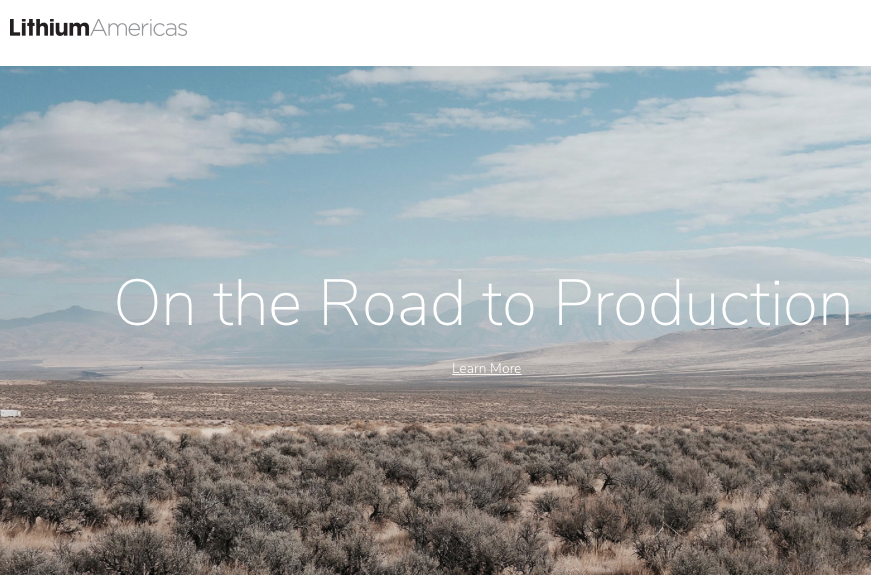Groups, Tribes Ask Appeals Court to Halt Nevada Lithium Mine
February 28, 2023 Reno NV - A federal judge last week refused to block the Thacker Pass mine from moving forward while appeals are heard. Red about it here: https://subscriber.politicopro.com/article/eenews/2023/02/28/greens-tribes-ask-appeals-court-to-halt-nevada-lithium-mine-00084699
Conservation Groups Seek Emergency Halt of Destructive Lithium Mine Pending Court Appeal
February 21, 2023 - RENO, Nev. – Conservation groups filed an emergency motion in federal court today, asking the court to enjoin the development of the Thacker Pass Lithium Mine until their case can be heard on appeal at the Ninth Circuit Court of Appeals. Earlier this month, Judge Du ruled that the Bureau of Land Management broke the law in approving the mine, but the court’s order didn’t halt development of the enormous open pit mine. Today’s filing requests that the court block ground disturbance and construction until compliance with federal laws is assured.
“This mine should not be allowed to destroy public land unless and until the Ninth Circuit has determined whether it was legally approved. There’s no evidence that Lithium Nevada will be able to establish valid mining claims to lands it plans to bury in waste rock and tailings, but the damage will be done regardless,” said Talasi Brooks, staff attorney with Western Watersheds Project.
If the project is not stopped pursuant to the emergency motion, the company has said it will proceed with the blasting of the mine pit, construction of the sulfuric acid processing plant and the development of other facilities that will imminently destroy critical wildlife habitat and public lands. All of these operations will irreparably damage thousands of acres of public land for a project that was illegally approved.
“There is no sustainable way to allow the excavation of a 2.3 mile long open pit that will remove over 17 million tons of rock and ore per year for 41 years.” said Kevin Emmerich, Co-Founder of Basin and Range Watch. “The flawed and fast-tracked approval of this mine would inflict long-term damage to a critical sage grouse population, scare off nesting golden eagles and potentially destroy the groundwater resources for an extensive area surrounding the project site. Construction activity should be halted until the Ninth Circuit can review the appeal. “
“This Thacker Pass mine has stirred up a hornet’s nest of opposition and become notorious for the environmental damage it will cause. It symbolizes BLM’s wrecking ball approach to “green” energy on public lands. We can, and must, do better and act to protect the beauty, biodiversity and sacred places of the West’s sagebrush sea. Instead, this huge mine would destroy irreplaceable habitats for sage-grouse, and the nesting sites of long-billed curlew, burrowing owl and many other declining species. It would also rip apart an area of great cultural importance ” said Katie Fite WildLands Defense Public Lands Director.
“The permitting of the Thacker Pass mine could set a dangerous precedent by allowing an illegal and inadequately analyzed mine to go forward,” said John Hadder, Director of Great Basin Resource Watch. To ensure that all is done to prevent avoidable enormous damage to the Thacker Pass region it is essential that the mine permit is vacated.”
Today’s court action seeks to stop site preparation activities at Thacker Pass which may begin as early as the end of this month according to the mine’s proponents.
Media contacts:
Talasi Brooks, Western Watersheds Project (208)336-9077; tbrooks@westernwatersheds.org
John Hadder, Great Basin Resource Watch, (775)348-1986; john@gbrw.org
Kevin Emmerich, Basin and Range Watch (775) 764 -1080; basinandrange@gmail.com
Katie Fite, WildLands Defense (208) 871-5738; katie@wildlandsdefense.org
Conservation and Public Accountability Groups to Argue the Illegality of the proposed Thacker Pass Lithium Mine
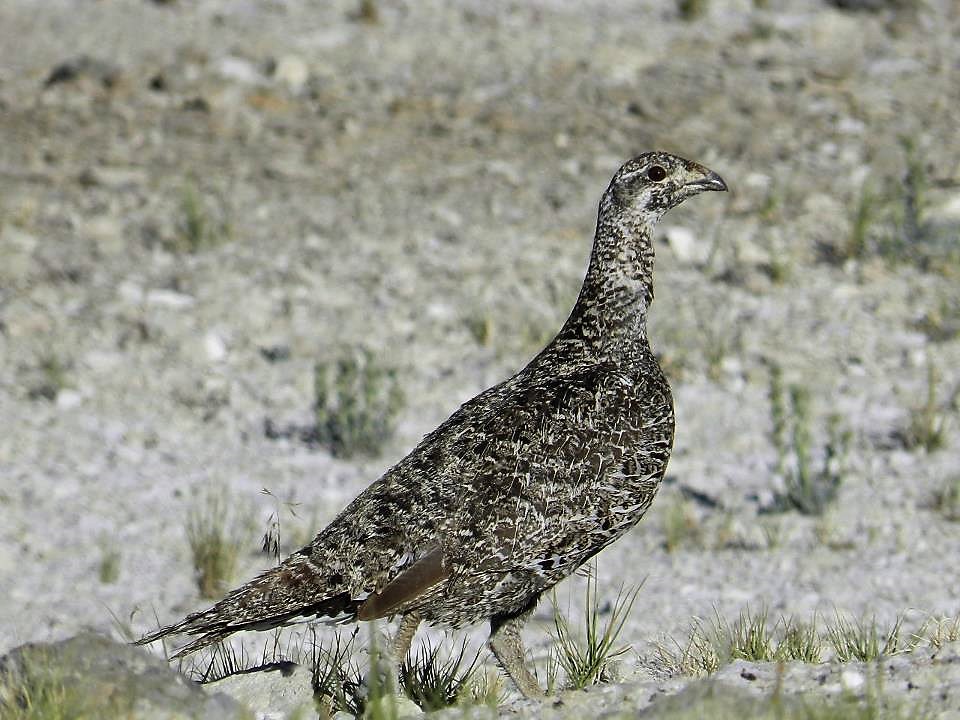
^Greater sage-grouse hen in Nevada. Photo: Kevin Emmerich.
January 4, 2023 - RENO, NV. — On Thursday January 5, 2023, the combined plaintiffs, a coalition of conservation and public accountability groups, Tribes, and Thacker Pass area rancher, will present oral arguments in opposition to the Thacker Pass Lithium Mine Final Environmental Impact Statement and Record of Decision in the District of Nevada, challenging the Bureau of Land Management’s (“Bureau”) approval of the Thacker Pass Lithium Mine. The mine was fast tracked by the Trump Administration and completed its environmental review process in less than one year despite the enormous environmental impact to the nearly 18,000 acres of public land that would be affected by the operation.
Plaintiffs will cite the Bureau’s violations of federal laws, including the National Environmental Policy Act and Federal Land Policy and Management Act, when it approved the Thacker Pass Lithium Mine’s Plans of Operation on January 15, 2021.
Thacker Pass is critically important to wildlife because it connects the Double H Mountains to the Montana Mountains. The pass also provides lower-elevation habitat that wildlife need to survive the winter. It will eliminate thousands of acres of the most important type of greater sage-grouse habitat and two pronghorn migration corridors. Golden eagles nesting in the nearby cliffs and canyons forage there for food to feed their chicks. Local springs are the only place in the world where the Kings River pyrg, a rare type of springsnail, are known to live.
Other wildlife at risk from the Thacker Pass mine include Endangered Species Act-listed Lahontan cutthroat trout, bighorn sheep, and pygmy rabbits.
“The Montana Mountains landscape has long been identified as a key area for biodiversity protection in Nevada,” said Katie Fite, Public Lands Director for Wildlands Defense. “Along with adjacent Oregon wild lands, it constitutes one of the last big blocks of the sagebrush sea free of development. Pygmy rabbits, migratory birds and other wildlife suffered a major blow from wildfire a decade ago and habitat has not yet recovered. Now this mega-mine will obliterate vital remaining sagebrush. The mine’s regional disturbance footprint will wallop struggling wildlife populations, causing new declines.”
Plaintiffs will further argue that BLM failed in its duty to protect public resources by allowing a mine that will be a source of groundwater pollution for at least 300 years and not requiring long-term financial assurances.
“The reckless permitting of the Thacker Pass lithium mine sets a bad precedent for the Energy Transition.” said John Hadder, Director of Great Basin Resource Watch. “We now have a situation where the BLM rushed ahead of the state of Nevada permitting process resulting in a federal permit that allows groundwater contamination from the mine pit rejected by the state of Nevada.”
“The Bureau of Land Management must manage Thacker Pass and connecting mountains to preserve essential sage grouse habitat, old growth sagebrush, golden eagle nests, endemic springsnails and additional wildlife,” said Kevin Emmerich, Co-Founder of Basin and Range Watch. “The unique viewshed and dark skies should be managed to retain the existing character of the landscape. The open pit, waste rock facilities, noise and water use required for the Thacker Pass Lithium Mine all would cause critical damage to a remaining stronghold for local wildlife, and the viewshed will be damaged forever.”
“We need a smart energy future that transitions our economy from fossil fuels to renewables without sacrificing rare species in the process,” said Greta Anderson, deputy director with Western Watersheds Project. “We can’t solve the climate crisis by deepening the biodiversity crisis.”
Modern large-scale mining is very destructive to the natural ecosystems and often disruptive to frontline communities. It is estimated by the United Nations International Resource Panel that, “90 percent of biodiversity loss and water stress are caused by resource extraction and processing.” And the Panel goes on to note that, “Annually, the extraction of metals and minerals has risen significantly, from 11.6 billion tons in 1970 to 53.1 billion tons in 2017, accounting for 20% of climate impacts.”
It is essential therefore that the citing of mining operations be done carefully, judiciously, and in a manner that allows for the full range of consequences of the proposed mine to be fully explored and addressed. Never is there a time to fast-track or “expedite” mine permitting even for lithium and other “energy transition” metals. Expediting is a step backward, which will accept incompletely analyzed mine plans that unnecessarily allow environmental damage and run over concerns of the directly affected communities. The permitting process for the proposed Thacker Pass Lithium mine serves as an example of what not to do and thus triggered these lawsuits.
According to Lithium Nevada Corporation’s Plans of Operation, the mine would entail:
● excavation of a large open pit roughly 2.3 miles long by about half a mile at the widest
● removal of 17.2 million tons of rock and ore per year (phase 2)
● direct surface disturbance of 5,694 acres (total project size would be 17,933 acres)
● on-site sulfuric acid plant - 5,800 tons of acid per day during phase 2
● ultimately pumping up to 1.7 billion gallons of water per year
● estimated lifetime of 41 years and 5 years of reclamation
Attorneys from Western Mining Action Project and Western Watersheds Project represent Western Watersheds Project, Great Basin Resource Watch, Basin and Range Watch, and Wildlands Defense.
Western Watersheds Project is a nonprofit environmental conservation group dedicated to protecting and restoring wildlife and watersheds throughout the American West.
Great Basin Resource Watch is a nonprofit public interest organization that works with communities to protect their health, land, air, water, and wildlife of the Great Basin from the adverse effects of mining and resource extraction.
Basin and Range Watch is a 501(c)(3) non-profit working to conserve the deserts of Nevada and California and to educate the public about the diversity of life, culture, and history of the ecosystems and wild lands of the desert.
Wildlands Defense works to inspire and empower the preservation of wild lands, wildlife and biodiversity in the West.
Contacts:
John Hadder, Great Basin Resource Watch, 775-348-1986; john@gbrw.org
Kevin Emmerich, Basin and Range Watch, 775-553-2806; emailbasinandrange@gmail.com
Katie Fite, Wildlands Defense, 208-871-5738; katie@wildlandsdefense.org
Greta Anderson, Western Watersheds Project, (520) 623-1878, greta@westernwatersheds.org
Basin & Range Watch Joins Group Lawsuit Challenging Destructive Thacker Pass Lithium Mine
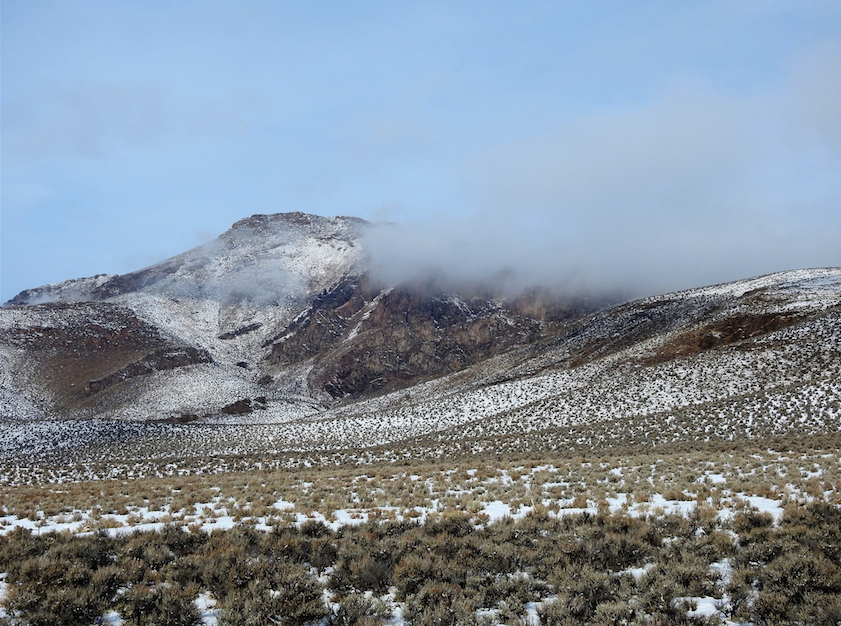
^Thacker Pass, Nevada, in winter. Photo: Kevin Emmerich.
February 26, 2021 - Winnemucca, Nevada - Basin and Range Watch joined a coalition of organizations to challenge the Thacker Pass Lithium Mine in northwestern Nevada, along with Western Watersheds Project, Great Basin Resource Watch, and Wildlands Defense, represented by attorneys from Western Mining Action Project. We support reasonable renewable energy and battery storage, but not at this cost to the environment and local communities.
^Lithium Americas' image on their website featuring Thacker Pass. https://www.lithiumamericas.com/thacker-pass/
Conservation and Public Accountability Groups File Legal Challenge to the Thacker Pass Lithium Mine
Reno, Nev. — Today a coalition of conservation and public accountability groups filed federal litigation in the District of Nevada, challenging the Bureau of Land Management’s approval of the Thacker Pass Lithium Mine. The mine was fast tracked by the Trump Administration and completed its environmental review process in less than one year despite its enormous environmental impacts.
“Renewable energy and electric cars aren’t green when they depend on mining that destroys important wildlife habitat and causes extinction,” said Kelly Fuller, Energy and Mining Campaign Director for Western Watersheds Project. “The Thacker Pass mine will devastate greater sage-grouse and other wildlife. We need to transition to renewables in an environmentally sustainable, rather than an environmentally problematic, way.”
Metals mining is the most polluting industry in the United States, and the local communities of Orovada and Kings River Valley are deeply concerned about how the mine will affect them.
“I am opposed to the Lithium mine being proposed for Thacker Pass,” said Wendelyn Muratore, Kings River Valley resident and member of Great Basin Resource Watch. “The impacts to our air quality, destruction of wildlife and habitat, dumping of hazardous chemicals, tightening of our water supply, increase in traffic at 75 semi trucks per day, and damage to our ranching and farming should make one stop and rethink this mine. Our communities along with our way of life and livelihoods should not be made to suffer in the name of ‘progress.’ ”
Thacker Pass is critically important to wildlife because it connects the Double H Mountains to the Montana Mountains. The pass also provides lower-elevation habitat that wildlife need to survive the winter. It contains thousands of acres of the most important type of greater sage-grouse habitat and two pronghorn migration corridors. Golden eagles nesting in the nearby cliffs and canyons forage there for food to feed their chicks. Local springs are the only place in the world where the Kings River pyrg, a rare type of springsnail, are known to live.
“The Bureau of Land Management must manage Thacker Pass and connecting mountains to preserve essential sage grouse habitat, old growth sagebrush, golden eagle nests, endemic springsnails and additional wildlife,” said Kevin Emmerich, Co-Founder of Basin and Range Watch. “The unique viewshed and dark skies should be managed to retain the existing character of the landscape. The open pit, waste rock facilities, noise and water use required for the Thacker Pass Lithium Mine all would cause critical damage to a remaining stronghold for local wildlife, and the viewshed will be damaged forever.”
Other wildlife at risk from the Thacker Pass mine include Endangered Species Act-listed Lahontan cutthroat trout, bighorn sheep, and pygmy rabbits.
“The Montana Mountains landscape has long been identified as a key area for biodiversity protection in Nevada,” said Katie Fite, Public Lands Director for Wildlands Defense. “Along with adjacent Oregon wild lands, it constitutes one of the last big blocks of the sagebrush sea free of development. Pygmy rabbits, migratory birds and other wildlife suffered a major blow from wildfire a decade ago and habitat has not yet recovered. Now this mega-mine will obliterate vital remaining sagebrush. The mine’s regional disturbance footprint will wallop struggling wildlife populations, causing new declines.”
Today’s legal complaint alleges that the Bureau of Land Management violated federal laws when it approved the Thacker Pass Lithium Mine’s Plans of Operation on January 15, 2021, including the National Environmental Policy Act and Federal Land Policy and Management Act.
“The reckless permitting of the Thacker Pass lithium mine sets a bad precedent for the Energy Transition.” said John Hadder, Director of Great Basin Resource Watch. “An example of getting the permit over good public process and addressing environmental and community concerns. Frontline communities like King River Valley and Orovada, Nevada that would shoulder effects of mining deserve an independent analysis of the mine and ask if all is being done to minimize the need for these raw materials.”
Plaintiffs further argue that BLM failed in its duty to protect public resources by allowing a mine that will be a source of groundwater pollution for at least 300 years and not requiring long-term financial assurances.
According to Lithium Nevada Corporation’s Plans of Operation, the mine would entail:
· excavation of a large open pit roughly 2.3 miles long by about half a mile at the widest
· removal of 17.2 million tons of rock and ore per year (phase 2)
· direct surface disturbance of 5,694 acres (total project size would be 17,933 acres)
· on-site sulfuric acid plant - 5,800 tons of acid per day during phase 2
· ultimately pumping up to 1.7 billion gallons of water per year
· estimated lifetime of 41 years and 5 years of reclamation
Attorneys from Western Mining Action Project and Western Watersheds Project represent Western Watersheds Project, Great Basin Resource Watch, Basin and Range Watch, and Wildlands Defense.
Western Watersheds Project is a nonprofit environmental conservation group dedicated to protecting and restoring wildlife and watersheds throughout the American West.
Great Basin Resource Watch is a nonprofit public interest organization that works with communities to protect their health, land, air, water, and wildlife of the Great Basin from the adverse effects of mining and resource extraction.
Basin and Range Watch is a 501(c)(3) non-profit working to conserve the deserts of Nevada and California and to educate the public about the diversity of life, culture, and history of the ecosystems and wild lands of the desert.
Wildlands Defense works to inspire and empower the preservation of wild lands, wildlife and biodiversity in the West.
Read the complaint >>here.
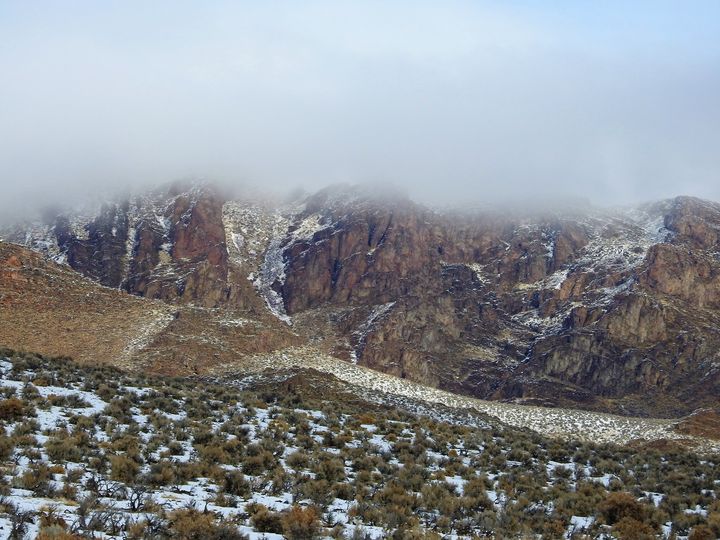
^Winter snowstorm at Thacker Pass. Photo: Kevin Emmerich.
Lithium Clays
Lithium-enriched clays are an active target of mining companies, including the Clayton Valley area. Strip-mining, drilling, and blasting are often needed to extract lithium from claystones, and a lesser extent from siltstones, and tuffaceous mudstones. Yet extraction of Lithium from the clay deposits requires sulfuric acid consumption. This is parallel to how gold is extracted from ore using hydrochloric acid, or more commonly sodium cyanide, potassium cyanide, or calcium cyanide solutions, which create hazardous and toxic waste streams.
On January 15, 2021, BLM approved the Thacker Pass Lithium Mine with an open pit mine on 5,695 acres of public land sagebrush-steppe in Humboldt County, Nevada. The total project area is 17,933 acres, including waste rock storage facilities, clay tailings, processing facility, haul roads, and 25 kV transmission power line.[2]Lithium-containing claystones are the target. Occasional blasting would be needed to expose basalt outcrops (Final Environmental Impact Statement p. 2-4).
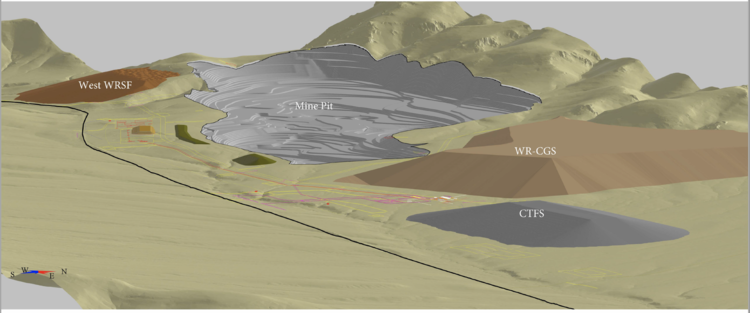
^Thacker Pass digital image of the open-pit Lithium mine and waste rock piles.
A lithium processing facility would include a sulfuric acid plant where scrubbed fine lithium-containing clay slurries would be processes using reagents including sulfur, quicklime, limestone, caustic soda, and soda ash. Products would include lithium carbonate, lithium sulfide, lithium hydroxide monohydrate, and lithium metal.
Concentrated sulfuric acid would be needed to leach lithium from the clay ore, so a sulfuric acid production plant would be built next to the mine, where sulfuric acid would be produced by burning molten sulfur with air to produce sulfur dioxide. Catalytically this would be converted to sulfur trioxide, and in reaction with water produce sulfuric acid. The waste heat in this chemical process would be captured to produce steam to turn a steam turbine that would generate electricity to be sold on the market (FEIS p. 2-9).
The lithium mine and associated groundwater pumping threatens imperiled greater sage-grouse, a pronghorn antelope migration corridor, golden eagles, federally threatened Lahontan cutthroat trout, a spring snail known as the King River pyrg that is known from only 13 isolated springs in the area, and rare plants such as Crosby’s buckwheat.
Activists set up an Occupy-style camp on these Bureau of Land Management lands where the Right-of-Way is approved, to resist and raise awareness of the un-green nature of soft clay lithium mining. See https://www.protectthackerpass.org
Spring snails:
The rare endemic King's River pyrg (Pyrgulopsis imperialis), a minute spring snail, inhabits the region forecast to have drastic groundwater drawdowns from open-pit Lithium mining at Thacker Pass.
The FEIS (at 4-10-11) says 7 perennial springs occrg in the vicinity of the proposed project, and could experience impacts from groundwater cone of depression and drawdown during mine operation.
Considering the uncertainty between the actual groundwater elevations and model-simulated groundwater elevations in this area, and the absence of data to define if these springs are perched or connected to the deeper groundwater aquifer system, the EIS analysis conservatively assumes that there is a potential risk that drawdown associated with the mine could reduce baseflow to perennial springs located within (or within one mile of) the maximum extent of the 10-foot drawdown contour. Depending on the severity, a reduction in baseflow could result in a spring drying up. Springs affected by drawdown and located in areas where the drawdown is predicted to persist over the model simulated post-closure period would not likely recover.
The EIS does not specify what types of surveys were undertaken for spring snails at these perennial springs. Nevada Division of Wildlife (pers. communication 2020) has explained how new spring snail (Pyrgulopsis, Tryonia) locations have been found during 2020 surveys at spring systems known for decades, as well as potential new species. The potential exists that that new spring snail sites could yet be discovered at these 7 springs with more thorough surveys. Drawdowns could result in extinctions of species. Simply monitoring groundwater levels will not ensure that spring snails will be protected in case of drawdown.
Cutthroat trout:
Thacker Creek, Pole Creek, and Crowley Creek are listed as perennial streams that also could have drawdown impacts as groundwater is pumped for the mine (FEIS 4-9). Detailed surveys for fish, cutthroat trout, Columbian spotted frog, and leopard frog need to be undertaken. Lahontan cutthroat trout populations in Pole and Crowley Creeks could be significantly impacted if drawdowns over the life of the project are not correctly modeled. Again, simply monitoring water levels will not be sufficient to protect trout.
Amphibians:
Potential toads in the area could have been missed and could if present around streams and springs represent undiscovered species of Bufo. Cryptic species are becoming gradually better known in Nevada with new research. See Godon et al. (2020), who acknowledge: "Additional study is required to advance our understanding of the fine-scale relationships among the toads within this species complex and work to identify cryptic taxa that may still remain undetected under the broad range of the Western Toad" (at 181).
The FEIS at H-7 and H-8 admits that "limited habitat" might be present for Northern leopard frog (Lithobates pipiens) and Columbian spotted frog (Rana luteiventris), and more surveys should be done. Frog stream surveys need to be repeated, and a pass without positive results may mean weather conditions or season was not optimal for detection.
Rare Plants:
Crosby’s buckwheat (Eriogonum crosbyae var. crosbyae)
was identified within the southwest corner of the south Exploration area during field surveys in 2018. (FEIS at 4-48) Effects were discounted and the populations would supposedly be avoided.
Yet many possible impacts to these rare plants were not analyzed in the EIS. We have observed large-scale mining activities, and many associated direct and indirect effects could impact plants: vehicle traffic crushing vegetation, piling up of topsoil for remediation, open pit excavation and storage of waste rock, dust, impacts to pollinators, weedy plant invasion, and disturbance of seed beds in soils.
A few plant surveys may not account for all the seed banks in the region of these plants, and differing years with rain patterns may trigger germination of annual plants or blooming of perennials to be different between years. More surveys should be undertaken to account for this inter-annual variation in the geography of rare plant phenology.
The Tiehm milkvetch (Astragalus tiehmii) was not found on the site during a survey, and described as "low probability of occurrence" at FEIS H-2, yet in Appendix H-3 the EIS notes that Crosby buckwheat frequently grows with Tiehm milkvetch. Therefore surveys might have missed this rare plant which could be present and impacted by mining activities.
Habitat for several species was found on the project site during surveys, but this does not preclude the presence of these rare plants--such as Soldier Meadow cinquefoil (Potentilla basaltica), on alkaline meadows (FEIS at H-7). Cordelia beardtongue (Penstemon floribundus) habitat is also present and more surveys could uncover this species during different weather years (FIES at H-8).
Sand-associated rare plants could be found on the project if even slight amounts of wind-blown sand deposits are found on the project site, and these should be surveyed for: Nevada dune beardtongue (Penstemon arenarius) requires sand (at H-5), but it may not need to be deep sand. Similarly Oryctes (Oryctes nevadensis), Tonopah milkvetch (Astragalus pseudiodanthus).
Sand cholla (Grusonia pulchella) is not an obligate sand plant, as the FEIS at H-4 determines. Ingram (2008) shows that sand cholla can grow easily in open sagebrush and saltbush in valleys just north of Winnemucca NV, habitats present on the project site. In addition, the visible portion of sand cholla may die back during dry years, but it survives as a tuber. Therefore sand cholla could easily exist on the project site but be missed during survey passes. There is no mitigation measure analyzed for this unusual cactus.
Many more surveys could be done and would likely uncover more rare plants in this valley, which need vetter analysis and mitigation.
References:
Gordon, M. R., E. T. Simandle, F. C. Sandmeier, and C. R. Tracy. 2020. Two New Cryptic Endemic Toads of Bufo Discovered in Central Nevada, Western United States (Amphibia: Bufonidae: Bufo [Anaxyrus]). Copeia 108(1), 166-183, (27 March 2020).
Ingram, S. 2008. Cacti, Agaves, and Yuccas of California and Nevada. Cachuma Press: Los Olivos CA.
Check out https://www.stoplithium.com/
Protect Thacker Pass Website: https://www.protectthackerpass.org/
Protect Thacker Pass Updates/Blog: https://www.protectthackerpass.org/blog/
HOME.....Lithium Mining
